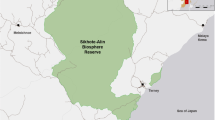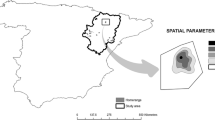Abstract
In this study, information concerning home range size and overlap of Calomys venustus (Thomas, 1894), in relation to sex, population size, and breeding periods is provided. The present study was carried out on a railway bank in southern Córdoba Province (Argentina), between October 1994 and September 1997, using the capture-mark-recapture method. Home range size in C. venustus depended on breeding period and population size, and was independent of sex. The degree of home range overlap was dependent on breeding and non-breeding periods and overlap type (intra-or intersexual), but was independent of population density. During the breeding period, females showed a small degree of intrasexual home range overlap. In general, male home ranges largely overlapped with females. The conclusion is that differences in home range size of C. venustus could be determined by season and population size. Moreover, the degree of inter- and intrasexual home range overlap during the breeding period suggested that males and females of C. venustus use space differently. Females did not share their home range with other females, while males fully shared it with both sexes, and male spacing is influenced by female distribution.
Zusammenfassung
In dieser Studie werden Ausdehnung und Überlappung der Wohngebiete von Calomys venustus (Thomas, 1894) untersucht in Beziehung zu den Variablen Geschlecht, Populationsdichte und während re-produktiver und nicht-reproduktiver Perioden. Die Datenerhebung erfolgte zwischen Oktober 1994 und September 1997 an Eisenbahndämmen im Süden der Provinz Córdoba, Argentinian mittels der Fang-Markierung-Neufang-Methode. Die Größe der Wohngebite von C. venustus war abhangig von Re-produktionsperiode und Populationsdichte, aber unabhängig vom Geschlecht. Der Grad der Überlappung der Wohngebite zeigte Abhangigkeiten von den Perioden und dem (intra- und intersexuellen) Überlappungstyp, war aber unabhängig von der Populationsdichte. Während der Reproduktionsperiode zeigten die Weibchen einen geringeren Grad von Überlappungen ihrer Wohngebiete. Im allgemeinen überlappten die Wohngebiete der männlichen Tiere deutlich diejenigen der weiblichen Tiere. Unsere Schlußfolgerung ist, daß sowohl Reproduktionsperiode als auch Größe der Population die Ausdehnung der Wohngebiete von C. venustus beeinflussen. Außerdem legt der Grad der inter- und intrasexuellen Überlappung während der Reproduktionszeit nahe, daß sowohl weibliche als auch männliche Indivi-duen ihre Wohngebiete auf unterschiedliche Weise nutzen: während die Weibchen das Gebiet nicht mit anderen Weibchen teilen, leben die Mannchen mit Individuen beider Geschlechter zusammen.
Similar content being viewed by others
References
Abramsky, Z.; Tracy, C. R. (1980): Relation between home range sizes and regulation of population size in Microtus ochrogaster. Oikos 34, 347–355.
Adler, G. M.; Wilson, M. L. (1987): Demography of a habitat generalist, the white-footed mouse, in a heterogeneous environment. Ecology 68, 1785–1796.
Batzli, G. O. (1968): Dispersion patterns of mice in California annual grassland. J. Mammalogy 49, 239–250.
Batzli, G. O.; Henttonen, H. (1993): Home range and social organization of the singing vole (Microtus miurus). J. Mammalogy 74, 868–878.
Bondrup-Nielsen, S. (1986): Analysis of spacing behaviour of females from a live-trapping study of Clethrionomys gapperi. Ann. Zool. Fenn. 23, 261–267.
Busch, M.; Kravetz, F. O. (1992): Competitive interactions among rodents (Akodon azarae, Calomys laucha, C. musculinus, and Oligoryzomys flavescens) in a two-habitat system. I. Spatial and numerical relationships. Mammalia 56, 45–56.
Cabrera, A. (1953): Esquema fitogeográfico de la República Argentina. Revista Museo de la Plata, Botánica 8, 87–168.
Castellarini, F. (1999): La alimentatión del roedor Calomys venustus en poblaciones dc Córdoba, Diss, thesis, Universidad Autónoma de Madrid, España.
Castellarini, F.; Agnelli, H.; Polop, J. J. (1998): Study on the diet and feeding pbl]References of Calomys venustus (Rodentia, Muridae). Mastozoología Neotropical 5, 5–11.
Desy, E. A.; Batzli, G. O.; Liu, J. (1989): Comparison of vole movements assessed by live trapping and radiotracking. J. Mammalogy 70, 652–656.
de Villafañe, G.; Bonaventura, S. M. (1987): Ecological studies in crop fields of the endemic area of Argentine haemorrhagic fever. Calomys musculinus movements in relation to habitat and abundance. Mammalia 51, 233–248.
de Villafañce, G.; Bonaventura, S. M.; Bel-Locq, M. L.; Percich, R. E. (1988): Habitat selection, social structure, density and prédation in populations of Cricetine rodents in the pampa region of Argentina and the effects of agricultural practices on them. Mammalia 52, 339–369.
Emlen, S. T.; Oring, L. W. (1977): Ecology, sexual selection, and the evolution of mating systems. Science 197, 215–223.
Erlinge, S.; Hoogenboom, I.; Agrell, I.; Nelson, I.; Sandell, M. (1990): Density-related home-range size and overlap in adult field voles (Microtus agrestis) in southern Sweden. J. Mammalogy 71, 597–603.
Fauske, I.; Andreassen, H. P.; Ims, R. A. (1997): Spatial organization in a small population of the root vole Microtus oeconomus in a linear habitat. Acta Theriol. 42, 49–90.
Gaines, M.; Johnson, M. (1982): Home range size an population dynamics in the prairie vole Microtus ochrogaster. Oikos 39, 63–70.
Gaulin, S. I.; Fitzgerald, R. W. (1988): Home range size as a predictor of mating systems in Microtus. J. Mammalogy 69, 311–319.
Getz, L. L. (1961): Home ranges, territoriality, and movement of the meadow vole. J. Mammalogy 42, 24–36.
Heske, E.J.; Ostfeld, R. S. (1990): Sexual dimorphism in size, relative size of testes, and mating systems in North American voles. J. Mammalogy 71, 510–519.
Hlxon, M. (1980): Food production and competitor density as determinants of feeding territory size. Am. Nat. 115, 510–530.
Hubbs, A. H.; Boonstra, R. (1998): Effects of food and predators on the home range size of arctic ground squirrels (Spermophilus parryii). Can. J. Zool. 76, 592–596.
Ims, R. A. (1987): Responses in spatial organization and behaviour to manipulations of the food resource in the vole Clethrionomys rufo-canus. J. Anim. Ecol. 56, 585–596.
Ims, R. A. (1988a): The potential for sexual selection in males: effect of sex ratio and spatio-temporal distribution of receptive females. Evol. Ecol. 2, 338–352.
Ims, R. A. (1988b): Spatial clumping of sexually receptive females induces space sharing among male voles. Nature 335, 541–543.
Jones, E. N. (1990): Effects of forage availability on home range and population density of Microtus pennsylvaniens. J. Mammalogy 71, 382–389.
Jennrich, R. I.; Turner, F. B. (1969): Measurement of noncircular home range. J. Theor. Biol. 22, 227–237.
Kravetz, F. O.; Polop, J. J. (1983): Comunidades de roedores en agroecosistemas del Departa-mento Río Cuarto, Córdoba. Ecosur 10, 1–18.
Krebs, C. J. (1966): Demographic changes in fluctuating populations of Microtus californiens. Ecol. Monogr. 36, 239–273.
Lindstedt, S. L.; Miller, B. L.; Buskirk, S. W. (1986): Home range, time and body size in mammals. Ecology 67, 413–418.
Loy, A.; Dupre, E.; Capanna, E. (1994): Territorial behavior in Talpa romana, a fossorial insectivore from south central Italy. J. Mammalogy 75, 529–535.
Madison, D. M. (1978): Movement indicators of reproductive events among female meadow voles as revealed by radiotelemetry. J. Mammalogy 59, 835–843.
Madison, D. M. (1980): Space use and social structure in meadow voles, Microtus pennsylvanicus. Behav. Ecol. Sociobiol. 7, 65–71.
Madison, D. M. (1985): Activity rhythms and spacing in biology of new world Microtus. In: Biology of New World Microtus. Ed. by R. H. Tamarin. Am. Soc. Mammal. Spec. Publ. 8, 373–413.
Mazurkiewicz, M. (1971): Shape, size and distribution of home ranges of Clethrionomys glareolus (Schreber 1780). Acta Theriol. 16, 23–60.
Mcshea, W. I.; Madison, D. M. (1992): Presaturation and saturation dispersal 15 years later: some theoretical considerations. In: Animal Dispersal, Small Mammals as a Model. Ed. By N. Ch. Stenseth and W. Z. Lidicker Jr. London: Chapman and Hall. Pp. 319–329.
Metzgar, L. H. (1971): Behavioral population regulation in the woodmouse, Peromyscus. Am. Midi. Nat. 86, 434–448.
Mills, H.; Ellis, B. A.; Mckee, K. T.; Maizte-Gui, J. I.; Childs, J. E. (1991): Habitat associations and relative densities of rodent populations in cultivated areas of central Argentina. J. Mammalogy 72, 470–479.
Nelson, J. (1995a): Determinants of male spacing behavior in microtines: an experimental manipulation of female spatial distribution and density. Beh. Ecol. Sociobiol. 37, 217–223.
Nelson, J. (1995b): Intrasexual competition and spacing behavior in male field voles, Microtus agrestis, under constant female density and spatial distribution. Oikos 73, 9–14.
Ostfeld, R. S. (1985): Limiting resources and territoriality in microtine rodents. Am. Nat. 126, 1–15.
Ostfeld, R. S. (1986): Territotiality and mating system of California voles. J. Anim. Ecol. 55, 691–706.
Ostfeld, R. S. (1990): The ecology of territoriality in small mammals. Trends Ecol. Evol. 5, 411–415.
Ostfeld, R. S.; Lidicker, W. Z., Jr.; Heske, J. (1985): The relationship between habitat heterogeneity, space use, and demography in a population of California voles. Oikos 45, 433–442.
Polop, J. J. (1996): Análisis de la respuesta adaptativa del género Calomys. Diss, thesis, Universidad Nacional de Río Cuarto, Argentina.
Polop, J. J.; Sabattini, M. S. (1993): Rodent abundance and distribution in habitats of Agroce-nosis in Argentina. Studies on Neotropical Fauna and Environment 28, 39–46.
Priotto, J. W.; Polop, J. J. (1997): Space and time use in syntopic populations of Akodon azarae and Calomys venustus (Rodentia, Muridae). Z. Säugetierkunde 62, 30–36.
Priotto, J. W.; Steinmann, A. R. (1999): Factors affecting home range size and overlap in Akodon azarae (Muridae: Sigmodontinae) in natural pasture of Argentina. Acta Theriol. 44, 37–44.
Ribble, D. O.; Stanley, S. (1998): Home range and social organization of syntopic Peromyscus boylii and P. truei. J. Mammalogy 79, 932–941.
Sokal, R. R.; Rohlf, E. J. (1981): Biometry. San Francisco: W. H. Freeman.
Stickel, L. F. (1954): A comparison of certain methods of measuring ranges of small mammals. J. Mammalogy 35, 1–5.
Swihart, R. K.; Slade, N. A. (1985): Influence of sampling interval on estimates of home range sizes. J. Wildl. Mgmt. 49, 1019–1025.
Swihart, R.; Slade, N. A.; Bergstrom, B. J. (1988): Relating body size to the rate of home range use in mammals. Ecology 69, 393–399.
Taitt, M. J. (1981): The effect of extra food on small rodent populations: I. Deer mice (Peromyscus maniculatus). J. Anm. Ecol. 50, 111–124.
Taitt, M. J.; Krebs, C. J. (1981): The effect of extra food on small rodent populations: II. Voles (Microtus townsendii). J. Anim. Ecol. 50, 125–137.
van Horne, B. (1982): Niches of adult and juvenile deer mice (Peromyscus maniculatus) in serai stages of coniferous forest. Ecology 63, 992–1003.
Webster, A. B.; Brooks, R. J. (1981): Social behavior of Microtus pennsylvanicus in relation to seasonal changes in demography. J. Mammalogy 62, 738–751.
Wollf, J. O. (1985): The effects of density, food, and interespecific interference on home range size in Peromyscus leucopus and Peromyscus maniculatus. Can. J. Zool. 63, 2657–2662.
Author information
Authors and Affiliations
Corresponding author
Rights and permissions
About this article
Cite this article
Priotto, J., Steinhann, A. & Polop, J. Factors affecting home range size and overlap in Calomys venustus (Muridae: Sigmodontinae) in Argentine agroecosystems. Mamm Biol 67, 97–104 (2002). https://doi.org/10.1078/1616-5047-00014
Received:
Accepted:
Published:
Issue Date:
DOI: https://doi.org/10.1078/1616-5047-00014




